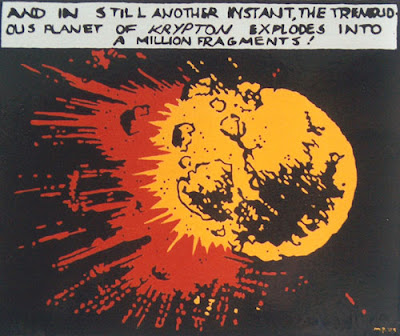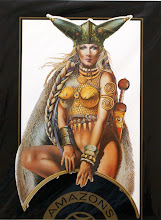His studies were soon interrupted by the Great War in which he served with the Bucks Hussars. After the war he resumed his artistic career but as a freelance illustrator. His first commission had come in 1915 for a series of humorous postcards but his big break came in 1921 when he placed his first work with the Amalgamated Press.
He found his true metier as the illustrator of the Sexton Blake detective yarns in 1922. His first Blake cover appeared on Union Jack in October 1922 and Parker soon became one of the main Blake artists. His strength, like Arthur Jones before him, was atmosphere. Some of his drawing could look crude—although his characters were always recognisable—but the atmosphere he imbued into his drawings was always perfect for the story it illustrated, whether the dark, sombre gloom of the Paris catacombs or the open prairies. Parker also proved to have a lighter side when required that could bring humour to the illustrations that accompanied 'Tinker's Notebook' and the 'Detective Supplement' pages.
H. W. Twyman, the editor of Union Jack, asked Parker to produce a bust of the renowned detective which appeared on the cover of Union Jack issue 1169 (6 March 1926) and copies of the bust were offered as prizes for promotional competitions. Twyman felt that Parker captured the essence of Sexton Blake so well that he appointed him the sole cover artist of the Sexton Blake Library from April 1929, a position he held until February 1953—a run of 842 covers. Other artists were introduced but Parker continued to produce occasional covers until 1959.
Parker's long association with Blake ran parallel to his work elsewhere, producing illustrations for The Strand, Pearson's, The Corner Magazine, Chums and other magazines and books throughout the 1920s and 1930s.
In 1939, Parker began working for the newly launched Knockout Comic as an illustrator on the long running 'Mickey's Pal the Wizard' text story. His work was championed by editor Edward Holmes, who had used Parker extensively on his previous title Wild West, and was to remain a favourite of Holmes' wartime replacement on Knockout, Percy Clark.
Parker switched from illustration to comic strips in 1939 when he drew the short-lived 'Tec Sharp' in Sports Budget a few weeks before the paper folded, followed in 1940 by 'The Queer Adventures of Patsy and Tim' in Knockout, the story of two children whose uncle invents some 'dwindling pills' that turn the youngsters into two dolls' clothes-wearing Tom Thumbs.
Parker went on to draw 'The Adventures of Bear Cub' (a young Indian boy) and 'Jimmy Jingles' Time Machine' before drawing the first of a number of literary adaptations in 'Gulliver's Travels'. More Lilliputian-like adventures followed in 'Frank and Ted, the Pocket-Size Cowboys', Frank Grey and Fred Smithers being two pals from a tribe of tiny people who lived in a lost valley in the Rockies.
Parker's adaptations over the next few years included 'Stories from the Arabian Nights', 'Peter the Whaler', 'Mr. Midshipman Easy', 'The Children of the New Forest', Kidnapped', 'The Three Musketeers' and 'Westward Ho!' before he revived a favourite from Wild West in comic strip form, 'The Phantom Sheriff'.
At the same time, Parker also began drawing newspaper strips, which he continued to produce into the 1950s. The most notable of these was 'Paula' which began appearing in the Daily Express in September 1946 relating the adventures of a young continuity girl in the exciting world of film studios. The strip was credited to no less a writer than Dennis Wheatley, although the day-to-day continuity was probably written by scriptwriter T. E. B. Clarke. Parker's other newspaper strips were 'Pepys Diary' (Evening News), 'Making a Film' (Daily Express), 'An Age of Greatness' (Daily Globe) and 'Our Gang' (Sunday Pictorial).
The last of Parker's literary adaptations, 'The Black Arrow' based on the novel by R. L. Stevenson, appeared in Knockout shortly before the movie starring Louis Hayward was released in the UK (as The Black Arrow Strikes). Ted Holmes now began featuring comic strip movie adaptations, with Parker producing the first, 'The Exile' based on the Douglas Fairbanks Jr. movie. His next strip for Knockout united him with the character he had helped define. 'Sexton Blake & Tinker in The Secret of Monte Cristo', written by Holmes, is often cited as one of the best of the Blake strips.
Over the next few years, Parker's output was as diverse as ever, ranging from westerns featuring Kit Carson, Buffalo Bill and Buck Jones for Knockout and Cowboy Comics to historicals ('The Quest of Midshipman West', 'Highway Days', 'Mr. Bash the Brutal', 'The Snare'). He also produced two episodes of 'Tommy Walls', the advertising strip published in Eagle.
One of Parker's most popular strips began appearing in Sun in February 1954. 'Max Bravo, the Happy Hussar' told the story of a young trooper in the 9th Hussars of the French Army serving under General Napoleon Bonaparte. The strip ran on the paper's colour centre pages and rear cover in colour for some years with Parker producing 87 episodes in all over a three-year period.
In June 1955, Parker began drawing the story of Nelson for Comet, also in colour. It was his work on 'Nelson' and 'Max Hussar' that confirmed Parker's talent for drawing historical subjects. Since the 1920s, Parker had been fascinated by military history and spent many hours in museums examining uniforms, adding to his knowledge of old-time military matters. Every historical strip and feature Parker drew benefited from his hobby as every uniform was accurate down to the last button, one notable feature being 'Soldiers of the Queen' for Comet which ran for six months in 1953-54.
In 1959, Leonard Matthews, the former editor of Knockout, Sun and Thriller Comics, had risen to the position of director of juvenile publications and set up a group within the department known as Experimental Art to create dummies for new publications. Parker was employed by the firm, now called Fleetway Publications, and assisted on the creation of Buster. His efforts were visible in the early issues in the title heading for 'The Sea Hawk', although the strip itself was drawn by Patrick Nicolle. Parker did draw in full the replacement strip, 'Three Rollicking Rogues', a humorous historical strip based on the three musketeers starring Filbert, Frollo and Florian.
Parker was involved heavily in the early creation of Experimental Art's next two successes: for Princess, launched in January 1960, Parker illustrated various stories by Enid Blyton and, in 1963-64, produced the full-colour strip 'The Daughter of Lorna Doone'; and for Look and Learn, launched in January 1962, he produced 'scamps'—rough layouts, sometimes in colour—of pages so that artists would know how the feature was envisaged. He was to provide similar roughs for other papers, including cover layouts for Valiant and page layouts for Ranger.
Parker did not give up strip illustration entirely, although his work during the 1960s was as a feature artist, contributing to 'Do You Know Your Name?' and 'Ticket to Adventure' in Boy's World before launching a long running series of features with 'The Story of the Soldier' for Ranger. This began as an illustrated text feature which Parker developed into a full-page feature entitled 'My Scrapbook of the British Soldier' which Parker wrote as well as illustrated in colour.
This series drew on Parker's decades of study of British military history and found a perfect home in Look and Learn when Ranger merged with that paper in 1966. The follow-ups, 'Scrapbook of the British Sailor' ran for over a year in 1968-69 and 'For Valour' for six months in 1969-70. Parker did not limit himself to military history and also illustrated 'The Story of the Motor Car' in 1967, the comic strip 'Frazer's Folly' in 1972 and 'A Highland Journey', the story of Dr. Johnson's travels through Scotland, in 1973.
Parker was working on another back cover series for Look and Learn, to be called 'A Thousand Years of Spying' when he died in March 1974, aged 75.
Examples of Eric R. Parker's artwork can be found for sale at the Illustration Art Gallery.





























